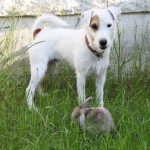The Fascinating World of Wild Rabbits
When it comes to the world of rabbits, wild rabbits are a captivating and diverse group of mammals. In this section, we will explore the intriguing aspects of wild rabbits, including their introduction and the diversity of species.
Introduction to Wild Rabbits
Wild rabbits are small to medium-sized mammals that belong to the family Leporidae. They are known for their long ears, powerful hind legs, and fluffy tails. These characteristics make them highly adapted for life in various habitats, ranging from grasslands to forests.
One of the distinguishing features of wild rabbits is their ability to reproduce rapidly. They have a short gestation period, and females can produce multiple litters throughout the year. This reproductive strategy allows the rabbit population to thrive even in challenging environments.
To learn more about the specific breeds of rabbits, visit our article on rabbit breeds.
The Diversity of Wild Rabbit Species
Wild rabbits exhibit an impressive diversity of species across the globe. From the European rabbit to the Amami rabbit, each species has unique characteristics and adaptations that enable them to survive in their respective habitats.
Here are a few examples of wild rabbit species:
| Species | Habitat | Range |
|---|---|---|
| European Rabbit | Meadows, grasslands, farmlands | Europe, North Africa, Southwestern Asia |
| Eastern Cottontail | Forests, fields, urban areas | Eastern and Central North America |
| Swamp Rabbit | Wetlands, swamps, riparian areas | Southeastern United States |
| Amami Rabbit | Forests, grasslands, coastal areas | Amami Ōshima island, Japan |
The diversity of wild rabbit species showcases their ability to adapt to various environments and thrive in different ecosystems.
While wild rabbits have their own unique charm, it’s important to also appreciate and understand the role of domestic rabbits in our lives. If you’re interested in learning more about domesticated rabbits, visit our article on domestic rabbits.
By delving into the fascinating world of wild rabbits, we can gain a deeper appreciation for these remarkable creatures and their place in the natural world. Stay tuned as we explore more aspects of their habitat, behavior, diet, and conservation efforts in the following sections.
Habitat and Range
Wild rabbits are found in a variety of habitats across the globe. Their adaptability allows them to thrive in diverse environments, ranging from grasslands and forests to deserts and wetlands. Let’s take a closer look at where wild rabbits live and the range of species they inhabit.
Where Wild Rabbits Live
Wild rabbits can be found on every continent except Antarctica. Their distribution is influenced by factors such as climate, food availability, and suitable shelter. Here are some common habitats where wild rabbits make their homes:
- Grasslands: Wild rabbits are well adapted to open grasslands, where they can find ample food and cover. They are particularly abundant in regions with a mix of grassy vegetation and shrubs.
- Forests: While not as common as in grasslands, wild rabbits can also be found in certain forested areas. They tend to prefer areas with clearings, understory vegetation, and leaf litter for shelter and foraging.
- Deserts: Some species, such as the desert cottontail, have successfully adapted to arid desert environments. They rely on the sparse vegetation for both food and shelter.
- Wetlands: Wetland habitats, including marshes and swamps, are home to various species of wild rabbits. These areas provide a rich supply of vegetation and offer protection from predators.
- Mountains: Certain species of wild rabbits, such as the mountain cottontail, are adapted to living in higher elevations. They can be found in mountainous regions, where they utilize the available vegetation for food and cover.
The Range of Wild Rabbit Species
There are numerous species of wild rabbits, each with its own unique range and distribution. Let’s explore some of the most well-known species and their geographic distribution:
| Wild Rabbit Species | Range |
|---|---|
| European Rabbit | Europe, parts of Africa, Australia, and New Zealand |
| Eastern Cottontail | Eastern and central parts of North America |
| Desert Cottontail | Southwestern United States and northern Mexico |
| Brush Rabbit | Western United States and Mexico |
| Marsh Rabbit | Southeastern United States and parts of Central America |
| Snowshoe Hare | Northern regions of North America and high mountain ranges |
| Pygmy Rabbit | Western United States and southwestern Canada |
It’s important to note that the range of wild rabbit species can vary within each species due to factors such as habitat destruction, climate change, and human intervention. To learn more about specific rabbit breeds, you can refer to our article on rabbit breeds.
Understanding the habitats and ranges of wild rabbits helps us appreciate their adaptability and the diverse ecosystems they inhabit. By preserving their natural habitats and protecting their populations, we can ensure the long-term survival of these fascinating creatures. To learn more about the lifespan of rabbits, visit our article on rabbit lifespan.
Physical Characteristics
Wild rabbits exhibit a range of unique physical characteristics that enable them to thrive in their natural habitats. Let’s explore their size and appearance as well as some unique adaptations that set them apart from other mammals.
Size and Appearance
Wild rabbits come in various sizes, depending on their species. On average, they have a compact and muscular body, covered in soft fur. The size of a wild rabbit can range from small to medium, with a typical length between 12 and 20 inches (30 to 50 centimeters) and a weight of 1 to 5 pounds (0.5 to 2.5 kilograms).
Their fur serves as excellent camouflage, blending with the colors of their surroundings. Wild rabbits often have a brown or grayish coat, which helps them remain inconspicuous and avoid detection by predators. The coloration can vary among species, providing them with an added advantage in their specific habitat.
Unique Adaptations of Wild Rabbits
Wild rabbits possess several unique adaptations that contribute to their survival in the wild. These adaptations include:
- Large Ears: One of the most distinctive features of wild rabbits is their large ears. These ears serve multiple purposes. They help rabbits detect sounds from a distance, allowing them to be aware of potential threats. Additionally, the large surface area of their ears aids in dissipating heat, helping to regulate their body temperature.
- Powerful Hind Legs: Wild rabbits are renowned for their remarkable agility and speed. They have powerful hind legs, which are longer and stronger than their front legs. These hind legs allow rabbits to make quick escapes from predators by leaping and zigzagging through the landscape. Their ability to reach impressive speeds is essential for their survival in the wild.
- Sharp Teeth: Wild rabbits possess sharp incisor teeth that continuously grow throughout their lives. These teeth are well-adapted for chewing and gnawing on vegetation, their primary source of food. The constant growth of their teeth ensures that they remain sharp and effective for foraging.
- Camouflage and Burrowing: Wild rabbits have evolved to blend into their surroundings, thanks to their fur coloration. This natural camouflage helps them stay hidden from predators. In addition, many wild rabbit species have adapted to create burrows in the ground as a means of shelter and protection. These burrows provide a safe haven for rabbits to retreat to during times of danger.
Understanding the physical characteristics and unique adaptations of wild rabbits gives us insight into their remarkable ability to thrive in diverse environments. To learn more about different rabbit species and their specific characteristics, check out our article on rabbit breeds. Additionally, if you’re interested in the lifespan of rabbits, you can read our article on rabbit lifespan. Remember, these characteristics may differ from those of domestic rabbits. For more information on domestic rabbits, visit our article on domestic rabbits.
Behavior and Social Structure
Wild rabbits exhibit fascinating behaviors and have a complex social structure that contributes to their survival in the wild. Understanding their social behavior and reproductive strategies can provide valuable insights into the lives of these captivating creatures.
Social Behavior of Wild Rabbits
Wild rabbits are social animals that typically live in groups known as colonies or warrens. These colonies consist of several individuals, ranging from a few to dozens of rabbits, depending on the availability of resources and the species. Living in groups provides numerous benefits, including increased protection against predators and improved access to food sources.
Within a colony, wild rabbits establish a hierarchical social structure. Dominant individuals, usually the older and more experienced ones, hold higher ranks and have priority access to resources such as food and preferred shelter. Lower-ranking individuals may have to wait their turn or settle for less desirable resources.
Rabbits within a colony also engage in various social interactions. Grooming is an essential behavior that promotes bonding and helps maintain the cleanliness of their fur. They also engage in playful activities, such as chasing and hopping around, which not only serve as a form of exercise but also strengthen social bonds among group members.
Communication and Reproduction
Wild rabbits communicate with each other using a combination of vocalizations, body language, and scent marking. Vocalizations include soft purring sounds, squeals, and occasional high-pitched screams when alarmed or threatened. Body language cues such as ear position, tail movement, and body postures convey different messages, including fear, aggression, or submission.
Reproduction plays a critical role in the survival of wild rabbit populations. The breeding season varies among species and regions, but it generally occurs during spring and summer when food resources are abundant. During this time, male rabbits compete for the attention of the females through displays of dominance and courtship behaviors.
Once mating occurs, female rabbits, also known as does, will typically dig a burrow or use existing underground structures to create a safe nesting site for their young. They give birth to a litter of kits, which are born hairless and blind. The mother provides care and protection to her offspring, returning to the nest to nurse them, usually at dawn and dusk.
By understanding the social behavior and reproductive strategies of wild rabbits, we gain a deeper appreciation for their ability to adapt and thrive in various habitats. If you’re interested in learning more about rabbit-related topics, consider exploring our articles on rabbit breeds and rabbit lifespan. While wild rabbits have captivated our attention, it’s also important to acknowledge the unique qualities and behaviors of domestic rabbits as cherished pets.
Diet and Feeding Habits
Wild rabbits have specific dietary needs that are essential for their survival and overall health. Understanding what wild rabbits eat and their foraging techniques can provide valuable insights into their natural behavior and ecological role.
What Wild Rabbits Eat
Wild rabbits primarily consume plant-based diets, consisting mainly of grasses, herbs, and leaves from various plant species. These herbivorous creatures have a specialized digestive system that allows them to efficiently process fibrous plant material.
The specific plants and vegetation that wild rabbits eat can vary depending on their habitat and the availability of food sources. Common food items for wild rabbits include:
| Food Item | Description |
|---|---|
| Grasses | A staple in the diet of wild rabbits, grasses provide essential nutrients and fiber. |
| Herbs | Wild rabbits often consume a variety of herbs, such as clover, dandelions, and plantain leaves. |
| Leaves | They also feed on the leaves of different shrubs and trees, including blackberry, raspberry, and maple. |
| Bark and Twigs | In harsh environments or during food scarcity, wild rabbits may resort to chewing on bark and twigs for sustenance. |
It’s important to note that wild rabbits have different dietary requirements than their domestic counterparts. Domestic rabbits, which have been selectively bred over generations, may have specific dietary needs and can consume a wider range of food. To learn more about rabbit breeds and their specific characteristics, refer to our article on rabbit breeds.
Foraging Techniques
Wild rabbits employ various foraging techniques to gather their food. Their behavior and feeding habits are influenced by factors such as habitat, season, and availability of resources. Some common foraging techniques observed in wild rabbits include:
- Browsing: Wild rabbits will browse through their environment, selectively feeding on vegetation that is within their reach. This method allows them to consume a diverse range of plant species.
- Grass Grazing: Grazing is a common feeding behavior in wild rabbits. They nibble on grasses and other low-lying vegetation, using their sharp incisor teeth to cut through the plant material.
- Selective Feeding: Wild rabbits have the ability to selectively choose their food based on nutritional value and taste. They may prefer certain plants over others, depending on their individual preferences and nutritional needs.
- Nighttime Feeding: Many wild rabbits are crepuscular or nocturnal, meaning they are most active during dawn, dusk, or nighttime. These periods offer them protection from predators, and they take advantage of the cover of darkness to forage for food.
By adapting their foraging techniques to their specific habitats, wild rabbits are able to find and consume the necessary food resources to meet their dietary requirements.
Understanding the diet and feeding habits of wild rabbits is essential for their conservation and management. By preserving their natural habitats and ensuring the availability of suitable food sources, we can help maintain healthy populations of these fascinating creatures. To learn more about the lifespan of rabbits and their life cycle, refer to our article on rabbit lifespan. Additionally, if you’re interested in domestic rabbits and their care, you can explore our article on domestic rabbits.
Predators and Threats
Wild rabbits face a variety of predators and threats in their natural habitat. Understanding these factors is crucial to gaining insight into the challenges that wild rabbits encounter on a daily basis.
Natural Predators of Wild Rabbits
In the wild, rabbits have evolved a range of strategies to deal with predators. However, they are still vulnerable to predation by a number of animals. Some of the natural predators of wild rabbits include:
| Predator | Description |
|---|---|
| Coyotes | Coyotes are skilled hunters and pose a significant threat to wild rabbits. They are fast and agile, making it difficult for rabbits to escape. |
| Foxes | Foxes are opportunistic predators and are known to prey on rabbits, especially during the breeding season when they are more active. |
| Birds of Prey | Raptors such as hawks, eagles, and owls have keen eyesight and sharp talons, making them formidable hunters of rabbits. They swoop down from the sky to catch their prey. |
| Snakes | Certain species of snakes, such as rattlesnakes and bullsnakes, are known to prey on rabbits. These snakes use their stealth and venom to capture and consume their prey. |
| Carnivorous Mammals | Predatory mammals like bobcats, weasels, and raccoons are also known to target rabbits as a food source. They employ various hunting techniques to catch their prey. |
It’s important to note that the specific predators of wild rabbits can vary depending on the region and habitat they inhabit. These predators play a crucial role in maintaining a balanced ecosystem.
Human Impact on Wild Rabbit Populations
While natural predators are a part of the wild rabbit’s ecosystem, human activities can also impact their populations. Some of the ways in which humans impact wild rabbit populations include:
- Habitat Loss: As human populations expand and develop, the natural habitats of wild rabbits are often destroyed or fragmented. Loss of habitat reduces their available food sources and increases their vulnerability to predators.
- Predation by Domestic Animals: Domestic animals, such as dogs and cats, can pose a threat to wild rabbits. When these animals are allowed to roam freely in natural areas, they may disturb rabbit habitats and prey on them.
- Hunting and Trapping: In certain regions, wild rabbits are hunted or trapped for various reasons, including sport, fur, or as a source of food. Unsustainable hunting practices can negatively impact rabbit populations if not regulated properly.
- Pesticides and Pollution: The use of pesticides and the pollution of water sources can have detrimental effects on wild rabbits. These substances can contaminate their food and water supply, leading to population decline or health issues.
Conservation efforts and responsible human activities are crucial for preserving wild rabbit populations. By raising awareness and taking steps to protect their habitats, we can help ensure the continued presence of these fascinating creatures in our ecosystems. Remember, even small actions can make a big difference. Learn more about rabbit breeds and their lifespan in our articles on rabbit breeds and rabbit lifespan.
What Are the Different Breeds of Wild Rabbits?
World rabbit breeds can vary greatly in their appearance and characteristics. Some popular breeds include the Flemish Giant, known for its large size, or the Netherland Dwarf, famous for its small stature. Other breeds like the Rex or Angora are recognized for their unique fur types. Each breed possesses distinct qualities that make them fascinating to study and admire.
Conservation and Protection
Conserving and protecting wild rabbits is essential to ensure their survival and maintain the delicate balance of ecosystems they inhabit. Efforts are being made by various organizations and individuals to safeguard these fascinating creatures and their habitats.
Efforts to Protect Wild Rabbits
Several conservation initiatives are focused on preserving and protecting wild rabbit populations. These efforts include:
- Habitat Conservation: Protecting and restoring the natural habitats of wild rabbits is crucial for their survival. Conservation organizations work to preserve and create suitable environments, such as grasslands, woodlands, and meadows, where rabbits can thrive. This involves implementing measures to minimize habitat destruction and ensuring the availability of food and shelter.
- Predator Management: Managing predator populations is an important aspect of protecting wild rabbits. While natural predators play a vital role in maintaining ecosystem balance, excessive predator populations can have a detrimental impact on rabbit populations. Conservation programs aim to strike a balance through predator control measures, such as habitat management and reducing predator-human conflicts.
- Public Awareness and Education: Raising awareness about the importance of wild rabbits and their conservation is crucial. Educational programs, public outreach initiatives, and media campaigns help to inform the public about the significance of these animals and the threats they face. By promoting understanding and appreciation, efforts can be made to protect their habitats and ensure their survival.
- Legislation and Policy: Governments and regulatory bodies play a vital role in protecting wild rabbits through legislation and policy development. These measures can include designating protected areas, establishing hunting regulations, and implementing programs to conserve endangered species.
How You Can Help
As an individual, there are several ways you can contribute to the conservation and protection of wild rabbits:
- Support Conservation Organizations: Consider donating to or volunteering with organizations that focus on wildlife conservation, including those specifically dedicated to protecting wild rabbits. Your support can aid in funding research, habitat restoration, and educational initiatives.
- Promote Responsible Land Management: If you own or manage land that overlaps with wild rabbit habitats, practice responsible land management techniques. This includes avoiding the use of harmful chemicals, maintaining natural vegetation, and providing suitable habitats for wild rabbits to thrive.
- Report Sightings and Encourage Monitoring: If you spot wild rabbits or signs of their presence, report your observations to local wildlife authorities or conservation organizations. This information helps researchers and conservationists better understand rabbit populations and their distribution.
- Advocate for Conservation: Use your voice to advocate for the protection of wild rabbits and their habitats. Share information about their importance and the challenges they face with others. Support initiatives that promote responsible wildlife management and conservation policies.
By taking action and contributing to conservation efforts, you can make a positive impact on the well-being of wild rabbits and help secure their future in the wild. For more information on rabbit-related topics, such as different rabbit breeds or the lifespan of rabbits, visit our articles on rabbit breeds and rabbit lifespan.









